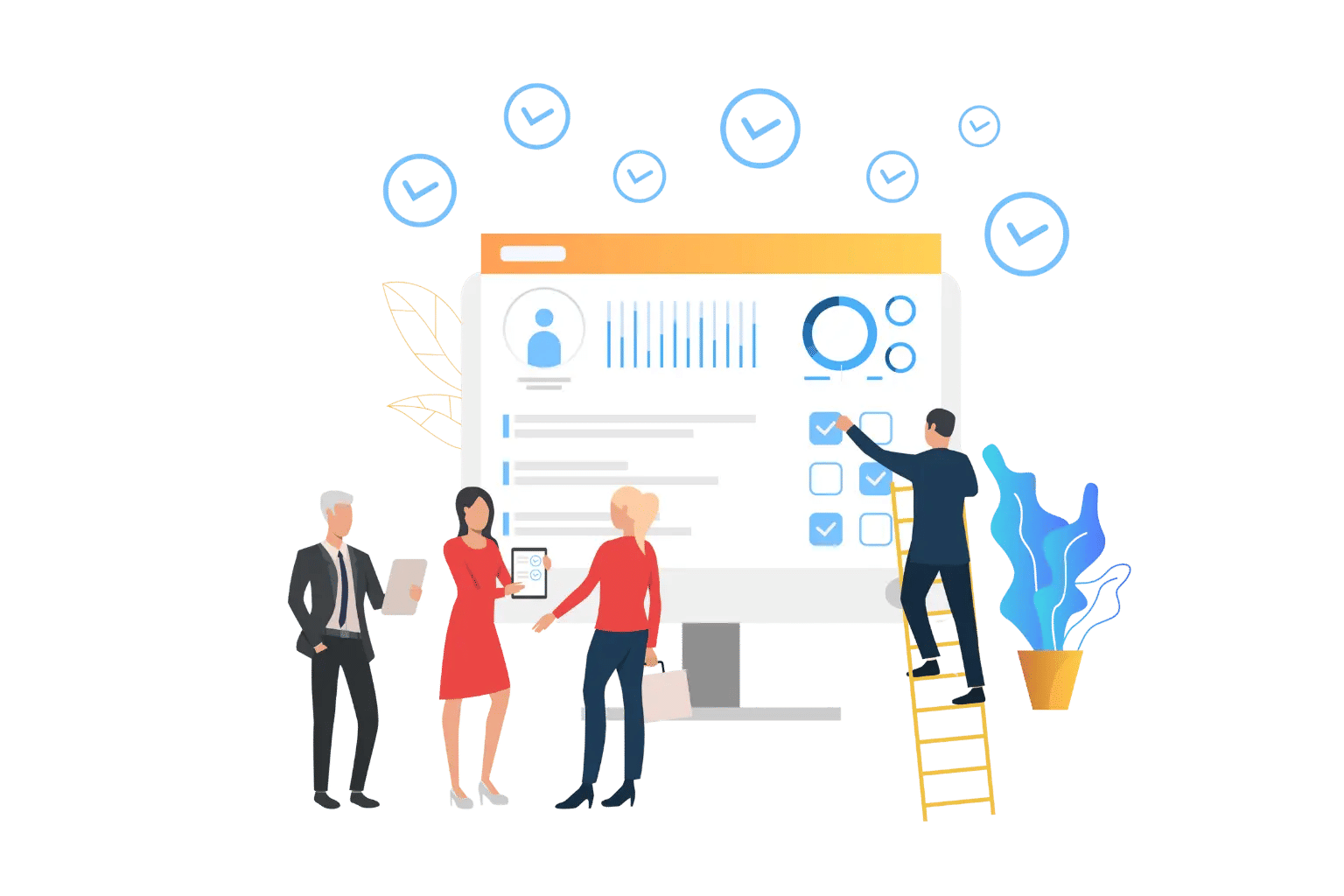
The Future of HR Onboarding Software: Key Trends to Expect in 2025
As we move into 2025, HR onboarding software is evolving faster than ever. In fact, over 50% of organizations plan to invest in new HR technologies this year, aiming to enhance employee engagement and streamline integration. From hybrid onboarding solutions to data-driven insights, the trends we’ll see in 2025 will reshape how HR teams approach employee success.
✨
Quick Read
Summary generated by AI, reviewed for accuracy.
HR onboarding software in 2025 is evolving with trends like remote onboarding, data-driven insights, and enhanced engagement tools. These innovations streamline processes and improve new hire experiences.
By integrating with other HR systems and adopting mobile-first, continuous, and DEI-focused onboarding, organizations boost retention, productivity, and employee satisfaction while creating a seamless, modern onboarding journey.
In this blog, we’ll explore the best HR onboarding software trends to watch for 2025, offering actionable insights that can transform your onboarding experience and drive long-term employee success.
1. Remote and Hybrid Onboarding Solutions
As remote and hybrid work models become the standard, HR onboarding software will focus on creating flexible, virtual onboarding processes that provide seamless integration for remote hires. With the right tools, you can ensure that remote employees feel just as connected and supported as in-office workers.
By offering a structured and engaging remote onboarding experience, you ensure that your new hires, regardless of location, have everything they need to succeed from day one.
Remote onboarding also requires HR teams to be mindful of communication barriers that may arise in virtual settings, making it crucial to foster an environment where new hires feel comfortable asking questions and seeking guidance.
How to Implement It:
- Cloud-Based Platforms: Use cloud-based onboarding solutions to provide accessible resources and training that new hires can access anytime and anywhere. Cloud platforms also allow for easy updates and scalability as your company grows.
- Virtual Onboarding Checklists: Implementing employee onboarding checklists to ensure new employees complete all necessary tasks, such as setting up email accounts, signing company policies, or receiving benefits information, even if they are working remotely.
- Virtual Team Building: Integrate virtual team-building activities to create a strong sense of community among remote hires and their in-office colleagues. Consider hosting regular video calls or online games to help break the ice and foster connections early on.
- Scheduled Check-ins: Ensure that managers and HR teams schedule regular check-ins with remote hires to assess their onboarding progress and provide feedback. These interactions help build rapport and ensure new hires feel supported throughout the onboarding process.
- Access to Digital Resources: Ensure all key resources such as handbooks, company policies, and training modules are available digitally, ensuring that remote employees are not left out of important information.
Why It Matters:
Remote and hybrid onboarding ensures a consistent experience, regardless of an employee’s physical location, promoting a cohesive and inclusive company culture. By leveraging the right technology, HR teams can ensure that remote employees are equipped with the tools and support they need through HR employee onboarding software, making them feel like a fully integrated part of the team.
2. Data-Driven Onboarding
The future of HR onboarding software will be increasingly data driven. Companies will leverage analytics to measure the effectiveness of onboarding programs, tracking metrics such as time-to-productivity, employee engagement, and retention. Data-driven insights will help HR teams continuously refine their onboarding processes to better meet employee and company needs.
By focusing on data, HR departments can identify bottlenecks in the onboarding journey and make targeted improvements to enhance the employee experience. Real-time data in HR onboarding software enables a more agile onboarding process, which helps organizations adapt quickly to changing workforce dynamics.
How to Implement It:
- Key Performance Indicators (KPIs): Track KPIs like completion rates for onboarding tasks, employee satisfaction surveys, and feedback on training effectiveness. These KPIs offer valuable insight into how well your onboarding process is working.
_ohPKdYIdS.webp)
- Real-Time Dashboards: Use onboarding platforms that offer real-time dashboards, providing HR with immediate insights into how new hires are progressing. These dashboards can help HR professionals track task completion, training progress, and identify any areas of concern early.
- Predictive Analytics: Use predictive analytics to identify patterns in employee success and engagement, allowing HR teams to make proactive adjustments to the onboarding process. By analyzing data from previous onboarding cohorts, HR can anticipate challenges and provide timely support to new hires.
- Surveys and Feedback Tools: Implement automated surveys and feedback tools at key stages of the onboarding process, collecting insights from employees that highlight pain points or areas for improvement.
- Benchmarking: Compare your onboarding performance metrics with industry standards to ensure that your processes remain competitive and aligned with best practices.
Why It Matters:
Data-driven decisions help HR onboarding software teams optimize their processes and ensure that onboarding programs are consistently aligned with organizational goals. By continually analysing performance and gathering feedback, organizations can fine-tune their Hr onboarding process, creating a more effective and engaging experience for new hires, improving retention, and boosting long-term success.
3. Enhanced Employee Engagement Tools
Engagement will be a top priority for onboarding in 2025. HR onboarding software will incorporate more tools that gamify the process, provide instant feedback, and offer personalized experiences to boost new hire engagement.
These tools help create an interactive and enjoyable onboarding experience, increasing new employee retention and satisfaction. With the rise of remote work, engagement tools also ensure that employees feel connected to the company and their colleagues, even from a distance.
By making onboarding more engaging and interactive, employees are not only motivated but also more likely to feel valued from the start.
How to Implement It:
- Gamification: Integrate gamified elements like points, badges, and challenges into onboarding, allowing new hires to earn rewards as they complete tasks and training. Gamification adds an element of fun to the process while motivating employees to stay engaged and meet milestones.
- Interactive Learning: Include interactive learning modules, quizzes, and assessments to make training more engaging and ensure employees retain important information. This helps maintain interest, especially in virtual onboarding programs.
- Instant Recognition: Provide systems that allow team members and managers to recognize new hires for their accomplishments in real time. Instant feedback and recognition ensure that employees feel appreciated and valued early in their journey with the company.
- Social Interaction Platforms: Integrate tools that allow new hires to interact socially with their colleagues, whether through virtual meetups, messaging channels, or team-building apps. This helps create a sense of belonging and encourages collaborative learning.
- Personalized Onboarding Pathways: Offer tailored onboarding experiences that align with an employee’s role, preferences, and learning style. This personalization increases engagement by ensuring new hires feel the onboarding process is specifically designed for them.
Why It Matters:
Employee engagement is directly linked to job satisfaction and retention. By integrating engagement tools into onboarding, companies can foster stronger emotional connections and improve long-term success. Engaged employees are not only more productive but also more likely to stay with the company, reducing turnover and promoting a positive company culture.
4. Integration with Other HR Systems
In 2025, onboarding software will no longer exist in isolation. Integration with other HR systems, such as benefits, performance management, and time tracking, will ensure a seamless experience for employees and HR teams. This integration with HR software for onboarding will create a unified employee experience, allowing HR teams to focus on strategic initiatives rather than managing separate systems.
A more connected HR ecosystem streamlines processes and enhances communication, ensuring that no data is lost between systems and reducing duplication of effort. With smooth integration, new hires can transition effortlessly between different stages of the employee lifecycle.
How to Implement It:
- Single Platform Integration: Adopt an integrated HR suite that combines onboarding and performance management into one cohesive platform. This ensures that all employee data is housed in one place, making it easier for HR teams to track progress and manage workflows.

Automatic Data Syncing: Ensure that data entered during onboarding is automatically synced with other HR systems, eliminating the need for manual data entry and reducing the risk of errors. This synchronization ensures that all employee records are up-to-date across the organization.

- Holistic Dashboards: Use dashboards that allow HR teams to see employee data across various functions, providing a comprehensive view of new hires’ progress and integration. HR professionals can easily monitor performance, track training completion, and identify areas where additional support might be needed.
- Seamless Communication Between Systems: Implement tools that facilitate communication between different HR systems, such as performance tracking and time management. This allows managers to access real-time data from multiple sources in a centralized location, improving decision-making processes.

- Customizable Reporting: Utilize customizable reports that pull data from integrated systems, providing HR teams with actionable insights into employee onboarding, performance trends, and engagement metrics.
Why It Matters:
Integrated HR systems reduce administrative burdens, increase data accuracy, and provide HR teams with a holistic view of employee progress and performance. With better data management, HR teams can make informed decisions quickly, improve employee experiences, and optimize the overall onboarding process through HR software for onboarding, contributing to higher employee satisfaction and retention.
5. Continuous Onboarding
The concept of continuous onboarding is gaining traction as companies move away from one-time orientation sessions to ongoing, evolving employee engagement. Continuous onboarding incorporates regular training, feedback, and development, ensuring that employees are supported throughout their entire journey at the company.
This approach recognizes that onboarding does not end after the first few weeks but is an ongoing process that helps employees grow, develop, and adapt to new challenges. By fostering a long-term view of employee success, continuous onboarding improves overall job satisfaction and strengthens employee loyalty.
How to Implement It:
- Onboarding Beyond the First 90 Days: Extend onboarding into the first year by offering additional learning modules, leadership training, and professional development opportunities. This helps employees feel continually supported and sets clear growth paths. With the support of onboarding automation, HR teams can streamline these ongoing activities, ensuring employees feel continually supported and have clear growth paths.
- Frequent Check-ins: Schedule regular check-ins between new hires and their managers to discuss progress, provide feedback, and set new goals. These conversations allow employees to address challenges, get advice, and align their objectives with the company’s needs.
- Ongoing Development: Offer continuous training opportunities that help employees grow in their roles and align with the company’s long-term vision. Focus on skills development, leadership growth, and adapting to new technologies.
- Mentorship Programs: Establish mentorship programs that continue beyond the initial onboarding phase. Mentors can help guide employees through ongoing learning and offer support as they advance in their roles.
- Access to Learning Platforms: Provide employees with continuous access to learning platforms, certifications, and webinars that allow them to pursue self-paced development and expand their skill sets over time.
Why It Matters:
Continuous onboarding fosters employee growth and engagement, helping employees stay connected to the organization and reducing turnover. By ensuring that employees feel valued and supported beyond their initial onboarding through HR employee onboarding software, companies can enhance retention, increase productivity, and create a workforce that is committed to long-term success.
6. Increased Focus on DEI (Diversity, Equity, and Inclusion)
In 2025, onboarding will place greater emphasis on diversity, equity, and inclusion (DEI). Organizations will use their HR onboarding software to reinforce DEI initiatives, ensuring that all employees feel welcomed and supported regardless of their background.
By integrating DEI into onboarding, companies can foster an inclusive environment from the very start of an employee’s journey. This focus not only contributes to a positive workplace culture but also helps build a more equitable organization that values diverse perspectives.
With DEI initiatives embedded into onboarding, employees can immediately feel the company’s commitment to equality, respect, and inclusivity.
How to Implement It:
- Inclusive Training: Integrate DEI training modules into the onboarding process, addressing topics like unconscious bias, cultural competency, and inclusive communication. Provide resources that educate employees on how to navigate a diverse and inclusive workplace.
- Employee Resource Groups (ERGs): Create virtual spaces where employees from diverse backgrounds can connect, share experiences, and find support. ERGs foster a sense of belonging and create a community that promotes understanding and inclusivity.
- Customizing Onboarding for Diverse Needs: Tailor onboarding materials to cater to diverse learning styles, language preferences, and accessibility needs, ensuring all employees feel included. This may involve providing translations of documents, offering flexible learning modules, or using tools designed for people with disabilities.
- Celebrating Cultural Differences: Acknowledge and celebrate the diverse cultural backgrounds of new hires during onboarding. This could include showcasing employee stories, holding cultural awareness sessions, or integrating diverse perspectives into training content.
- Mentorship Programs for Underrepresented Groups: Pair new hires from underrepresented groups with mentors who can offer guidance and support. This helps build confidence and provides employees with a trusted person to approach for career development.
Why It Matters:
Focusing on DEI during onboarding creates a more inclusive workplace and fosters a sense of belonging for all employees, leading to increased engagement and retention. Employees who feel valued and respected for their individuality are more likely to stay with the company, contribute to its growth, and become advocates for diversity and inclusion within the workplace.
7. Mobile-First Onboarding
As mobile usage continues to grow, HR onboarding software will become more mobile-friendly. A mobile-first approach allows new hires to complete onboarding tasks, access training materials, and engage with their team using their smartphones or tablets, making the process more flexible and accessible.
This shift accommodates the growing number of employees who prefer using mobile devices over desktops, enabling them to engage with onboarding content anytime and anywhere.
Additionally, a mobile-first approach allows HR teams to reach employees during all stages of their onboarding process, making sure they stay on track without needing to be tied to a desk.
How to Implement It:
- Mobile-Friendly Onboarding Platforms: Ensure your onboarding platform is mobile-responsive, allowing employees to complete tasks and engage with content from any device. This allows new hires to get started on their onboarding journey from the moment they are hired, whether they are on a mobile device, tablet, or computer.
- Push Notifications: Use mobile push notifications to remind new hires of important tasks or upcoming deadlines, keeping them on track throughout the onboarding process. Notifications for key actions (like benefits enrollment, training deadlines, or first-day meetings) ensure that employees stay engaged and organized.
- Mobile Access to Resources: Provide mobile access to company handbooks, training videos, and other resources, allowing employees to engage with the content at their convenience. This flexibility helps remote employees or those with busy schedules access important information on the go.
- Interactive Mobile Features: Include interactive features like quizzes, polls, or feedback options within the mobile platform to keep new hires engaged and provide valuable insights to HR teams. This helps make the onboarding process feel more dynamic and personalized.
- Offline Capabilities: Ensure the mobile platform works even without an internet connection, enabling new hires to access essential materials and complete tasks anytime, anywhere, even in areas with limited connectivity.
Why It Matters:
A mobile-first approach to onboarding increases accessibility and flexibility, allowing employees to engage with the process at their own pace and from anywhere. By providing employees with the tools to navigate their onboarding journey on their terms, companies can ensure higher completion rates, improve engagement, and enhance the overall employee experience, especially for remote or mobile-first teams.
Conclusion
HR onboarding software in 2025 will focus on integration, data-driven insights, and continuous employee engagement. These trends will help organizations improve retention, productivity, and overall employee satisfaction. By adopting modern tools, HR teams can simplify processes and create a seamless onboarding journey. Want to experience it firsthand? Book a demo today and see the difference.
Join Our Creative Community
Frequently Asked Questions
What is the role of HR onboarding software in improving employee experience?
HR onboarding software helps streamline the onboarding process by automating tasks, tracking progress, and providing new hires with essential resources. Using this software ensures a smooth and consistent experience, helping employees feel engaged and prepared from day one.
Which is the best HR onboarding software for small and medium businesses?
The best HR onboarding software offers a balance of automation, integration with HR systems, and personalized onboarding paths. It allows organizations to efficiently manage tasks like document submission, training schedules, and feedback collection, improving employee satisfaction and retention.
How does HR employee onboarding software support remote teams?
HR employee onboarding software provides digital tools such as virtual checklists, learning modules, and communication platforms, ensuring that remote hires feel connected to the company. This software helps bridge gaps caused by physical distance and promotes a consistent onboarding experience.
Why should organizations invest in HR software for onboarding new employees?
HR software for onboarding streamlines repetitive tasks, integrates with other HR systems, and tracks employee progress in real-time. Investing in such software allows HR teams to focus on strategic initiatives while ensuring new hires are supported throughout their onboarding journey.
How do companies choose HR onboarding software that employees actually use?
Companies should evaluate HR onboarding software based on ease of use, mobile accessibility, integration with existing tools, and features that enhance engagement. Software that is intuitive and provides a seamless user experience encourages employees to actively participate in their onboarding process.


_mVFFaHUZhS.webp)


_JiluXJRGNl.svg)



















